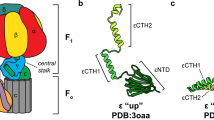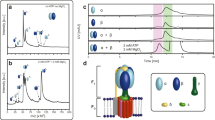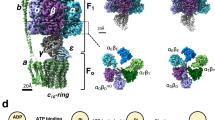Abstract
ATP, the main biological energy currency, is synthesized from ADP and inorganic phosphate by ATP synthase in an energy-requiring reaction1,2,3. The F1 portion of ATP synthase, also known as F1-ATPase, functions as a rotary molecular motor: in vitro its γ-subunit rotates4 against the surrounding α3β3 subunits5, hydrolysing ATP in three separate catalytic sites on the β-subunits. It is widely believed that reverse rotation of the γ-subunit, driven by proton flow through the associated Fo portion of ATP synthase, leads to ATP synthesis in biological systems1,2,3,6,7. Here we present direct evidence for the chemical synthesis of ATP driven by mechanical energy. We attached a magnetic bead to the γ-subunit of isolated F1 on a glass surface, and rotated the bead using electrical magnets. Rotation in the appropriate direction resulted in the appearance of ATP in the medium as detected by the luciferase–luciferin reaction. This shows that a vectorial force (torque) working at one particular point on a protein machine can influence a chemical reaction occurring in physically remote catalytic sites, driving the reaction far from equilibrium.
This is a preview of subscription content, access via your institution
Access options
Subscribe to this journal
Receive 51 print issues and online access
$199.00 per year
only $3.90 per issue
Buy this article
- Purchase on Springer Link
- Instant access to full article PDF
Prices may be subject to local taxes which are calculated during checkout




Similar content being viewed by others
References
Boyer, P. D. The ATP synthase—a splendid molecular machine. Annu. Rev. Biochem. 66, 717–749 (1997)
Kinosita, K. Jr, Yasuda, R., Noji, H. & Adachi, K. A rotary molecular motor that can work at near 100% efficiency. Phil. Trans. R. Soc. Lond. B 355, 473–489 (2000)
Yoshida, M., Muneyuki, E. & Hisabori, T. ATP synthase—a marvellous rotary engine of the cell. Nature Rev. Mol. Cell Biol. 2, 669–677 (2001)
Noji, H., Yasuda, R., Yoshida, M. & Kinosita, K. Jr Direct observation of the rotation of F1-ATPase. Nature 386, 299–302 (1997)
Abrahams, J. P., Leslie, A. G. W., Lutter, R. & Walker, J. E. Structure at 2.8 Å resolution of F1-ATPase from bovine heart mitochondria. Nature 370, 621–628 (1994)
Boyer, P. D. & Kohlbrenner, W. E. in Energy Coupling in Photosynthesis (eds Selman, B. R. & Selman-Reimer, S.) 231–240 (Elsevier, Amsterdam, 1981)
Oosawa, F. & Hayashi, S. The loose coupling mechanism in molecular machines of living cells. Adv. Biophys. 22, 151–183 (1986)
Yasuda, R., Noji, H., Kinosita, K. Jr & Yoshida, M. F1-ATPase is a highly efficient molecular motor that rotates with discrete 120° steps. Cell 93, 1117–1124 (1998)
Turina, P., Samoray, D. & Gräber, P. H+/ATP ratio of proton transport-coupled ATP synthesis and hydrolysis catalysed by CF0F1-liposomes. EMBO J. 22, 418–426 (2003)
Zhou, Y., Duncan, T. M. & Cross, R. L. Subunit rotation in Escherichia coli FoF1–ATP synthase during oxidative phosphorylation. Proc. Natl Acad. Sci. USA 94, 10583–10587 (1997)
McElroy, W. D., Seliger, H. H. & White, E. H. Mechanism of bioluminescence, chemiluminescence and enzyme function in the oxidation of firefly luciferin. Photochem. Photobiol. 10, 153–170 (1969)
Hattori, N., Kajiyama, N., Maeda, M. & Murakami, S. Mutant luciferase enzymes from fireflies with increased resistance to benzalkonium chloride. Biosci. Biotechnol. Biochem. 66, 2587–2593 (2002)
Yasuda, R., Noji, H., Yoshida, M., Kinosita, K. Jr & Itoh, H. Resolution of distinct rotational substeps by submillisecond kinetic analysis of F1-ATPase. Nature 410, 898–904 (2001)
Berg, H. C. The rotary motor of bacterial flagella. Annu. Rev. Biochem. 72, 19–54 (2003)
Yoshida, M. The synthesis of enzyme-bound ATP by the F1-ATPase from the thermophilic bacterium PS3 in 50% dimethylsulfoxide. Biochem. Biophys. Res. Commun. 114, 907–912 (1983)
Sakamoto, J. Effect of dimethylsulfoxide on ATP synthesis by mitochondrial soluble F1-ATPase. J. Biochem. 96, 483–487 (1984)
Wolcott, R. G. & Boyer, P. D. The reversal of the myosin and actomyosin ATPase reactions and the free energy of ATP binding to myosin. Biochem. Biophys. Res. Commun. 57, 709–716 (1974)
Mannherz, H. G., Schenck, H. & Goody, R. S. Synthesis of ATP from ADP and inorganic phosphate at the myosin-subfragment 1 active site. Eur. J. Biochem. 48, 287–295 (1974)
Wang, H. & Oster, G. Energy transduction in the F1 motor of ATP synthase. Nature 396, 279–282 (1998)
Oishi, N. & Sugi, H. In vitro ATP-dependent F-actin sliding on myosin is not infuenced by substitution or removal of bound nucleotide. Biochim. Biophys. Acta 1185, 346–349 (1994)
Menz, R. I., Walker, J. E. & Leslie, A. G. W. Structure of bovine mitochondrial F1-ATPase with nucleotide bound to all three catalytic sites: implications for the mechanism of rotary catalysis. Cell 106, 331–341 (2001)
Freitag, S., Trong, I. L., Klumb, L., Stayton, P. S. & Stenkamp, R. E. Structural studies of the streptavidin binding loop. Protein Sci. 6, 1157–1166 (1997)
Acknowledgements
We thank T. Hayakawa and T. Hiruma of Hamamatsu Photonics KK who allowed H.I. to work on this project for more than 6 years; S. Brenner for the idea of using microdroplets; M. Sugai for initial work; M. Shio, members of the former CREST Team 13 and the current Kinosita and Yoshida laboratories for help and advice; I. Mizuno, K. Suzuki, S. Uchiyama and Y. Mizuguchi for the photon-counting system; C. Gosse and H. Miyajima for the magnetic tweezers; K. Abe and K. Rikukawa for microscopy; S. Murakami for luciferase; and H. Umezawa and M. Fukatsu for laboratory management. This work was supported in part by Grants-in-Aid from the Ministry of Education, Culture, Sports, Science and Technology of Japan, and Burroughs Wellcome Fund (R.Y.).
Author information
Authors and Affiliations
Corresponding author
Ethics declarations
Competing interests
The authors declare that they have no competing financial interests.
Supplementary information
Rights and permissions
About this article
Cite this article
Itoh, H., Takahashi, A., Adachi, K. et al. Mechanically driven ATP synthesis by F1-ATPase. Nature 427, 465–468 (2004). https://doi.org/10.1038/nature02212
Received:
Accepted:
Issue Date:
DOI: https://doi.org/10.1038/nature02212
This article is cited by
-
Directed proton transfer from Fo to F1 extends the multifaceted proton functions in ATP synthase
Biophysical Reviews (2023)
-
Artificial Photosynthesis(AP): From Molecular Catalysts to Heterogeneous Materials
Chemical Research in Chinese Universities (2022)
-
Structural basis of redox modulation on chloroplast ATP synthase
Communications Biology (2020)
-
Kinetic asymmetry allows macromolecular catalysts to drive an information ratchet
Nature Communications (2019)
-
Reconstitution of FoF1-ATPase-based biomimetic systems
Nature Reviews Chemistry (2019)
Comments
By submitting a comment you agree to abide by our Terms and Community Guidelines. If you find something abusive or that does not comply with our terms or guidelines please flag it as inappropriate.



